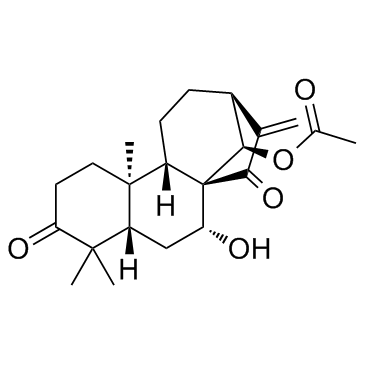Glaucocalyxin B |
| Catalog No.GC33085 |
La glaucocalyxine B est un diterpénoÏde ent kaurane isolé de la médecine traditionnelle chinoise Rabdosia japonica avec une activité anticancéreuse et antitumorale; diminue la croissance des cellules HL-60 avec une IC50 d'environ 5,86 μM À 24 h.
Products are for research use only. Not for human use. We do not sell to patients.

Cas No.: 80508-81-2
Sample solution is provided at 25 µL, 10mM.
Glaucocalyxin B is an ent kaurane diterpenoid isolated from the Chinese traditional medicine Rabdosia japonica with anticancer and antitumor activity; decreases the growth of HL-60 cells with an IC50 of approximately 5.86 μM at 24 h.
Glaucocalyxin A (GlnA) and (GlnB) dose-dependently decrease the growth of HL-60 cells with an IC50 of approximately 6.15 and 5.86 µM at 24 h, respectively. Both Gln A and B could induce apoptosis, G2/M-phase cycle arrest, DNA damage and the accumulation of reactive oxygen species (ROS) in HL-60 cells[1]. GlnB inhibits the proliferation of human cervical cancer cells in vitro through the induction of apoptosis andautophagy, which may be mediated by the phosphatidylinositol 4,5 bisphosphate 3 kinase/Akt signaling pathway. Treatment with GlnB inhibits the proliferation of HeLa and SiHa cervical cancer cell lines in a dose dependent manner. GlnB increases the apoptotic cell population of and enhanced poly (ADP ribose) polymerase 1 cleavage. GlnB also induces increased light chain 3 II/I protein cleavage, indicating the induction of autophagy. GlnB treatment increases the expression of phosphatase and tensin homolog and decreases the expression of phosphorylated protein kinase B[2]. Glaucocalyxin B (GLB), one of five ent-kauranoid diterpenoids, significantly decreased the generation of nitric oxide (NO), tumor necrosis factor (TNF)-α, interleukin (IL)-1β, cyclooxygenase (COX)-2 and inducible nitric oxide synthase (iNOS) in the lipopolysaccharide (LPS)-activated microglia cells[3].
[1]. Yang WH, et al. Glaucocalyxin A and B-induced cell death is related to GSH perturbation in human leukemia HL-60 cells. Anticancer Agents Med Chem. 2013 Oct;13(8):1280-90. [2]. Pan Y, et al. Glaucocalyxin B induces apoptosis and autophagy in human cervical cancer cells. Mol Med Rep. 2016 Aug;14(2):1751-5. [3]. Gan P, et al. Anti-inflammatory effects of glaucocalyxin B in microglia cells. J Pharmacol Sci. 2015 May;128(1):35-46.
Cell experiment: | The microglia cells viability is assessed by MTT assay. Cells are seeded in 96-well plates at the density of 5 × 104 cells/well. The cell culture supernatant is discarded after treatment with various agents, and then 30 μL of MTT (0.5 mg/mL) solution is added into each well. After incubation for 4 h at 37 °C, 100 μL of DMSO is added into each well to dissolve the formazan dye, and then the absorbance of solubilized formazan is measured by microplate reader[3]. |
References: [1]. Yang WH, et al. Glaucocalyxin A and B-induced cell death is related to GSH perturbation in human leukemia HL-60 cells. Anticancer Agents Med Chem. 2013 Oct;13(8):1280-90. | |
| Cas No. | 80508-81-2 | SDF | |
| Canonical SMILES | CC1(C)C(CC[C@@]2(C)[C@@]3([H])[C@@]4(C(C([C@H](CC3)[C@H]4OC(C)=O)=C)=O)[C@H](O)C[C@]12[H])=O | ||
| Formula | C22H30O5 | M.Wt | 374.47 |
| Solubility | Soluble in DMSO | Storage | Store at -20°C |
| General tips | Please select the appropriate solvent to prepare the stock solution according to the
solubility of the product in different solvents; once the solution is prepared, please store it in
separate packages to avoid product failure caused by repeated freezing and thawing.Storage method
and period of the stock solution: When stored at -80°C, please use it within 6 months; when stored
at -20°C, please use it within 1 month. To increase solubility, heat the tube to 37°C and then oscillate in an ultrasonic bath for some time. |
||
| Shipping Condition | Evaluation sample solution: shipped with blue ice. All other sizes available: with RT, or with Blue Ice upon request. | ||
| Prepare stock solution | |||

|
1 mg | 5 mg | 10 mg |
| 1 mM | 2.6704 mL | 13.3522 mL | 26.7044 mL |
| 5 mM | 0.5341 mL | 2.6704 mL | 5.3409 mL |
| 10 mM | 0.267 mL | 1.3352 mL | 2.6704 mL |
Step 1: Enter information below (Recommended: An additional animal making an allowance for loss during the experiment)
 g
g
 μL
μL

Step 2: Enter the in vivo formulation (This is only the calculator, not formulation. Please contact us first if there is no in vivo formulation at the solubility Section.)
Calculation results:
Working concentration: mg/ml;
Method for preparing DMSO master liquid: mg drug pre-dissolved in μL DMSO ( Master liquid concentration mg/mL, Please contact us first if the concentration exceeds the DMSO solubility of the batch of drug. )
Method for preparing in vivo formulation: Take μL DMSO master liquid, next addμL PEG300, mix and clarify, next addμL Tween 80, mix and clarify, next add μL ddH2O, mix and clarify.
Method for preparing in vivo formulation: Take μL DMSO master liquid, next add μL Corn oil, mix and clarify.
Note: 1. Please make sure the liquid is clear before adding the next solvent.
2. Be sure to add the solvent(s) in order. You must ensure that the solution obtained, in the previous addition, is a clear solution before proceeding to add the next solvent. Physical methods such as vortex, ultrasound or hot water bath can be used to aid dissolving.
3. All of the above co-solvents are available for purchase on the GlpBio website.
Quality Control & SDS
- View current batch:
- Purity: >99.00%
- COA (Certificate Of Analysis)
- SDS (Safety Data Sheet)
- Datasheet
Average Rating: 5 (Based on Reviews and 22 reference(s) in Google Scholar.)
GLPBIO products are for RESEARCH USE ONLY. Please make sure your review or question is research based.
Required fields are marked with *



















